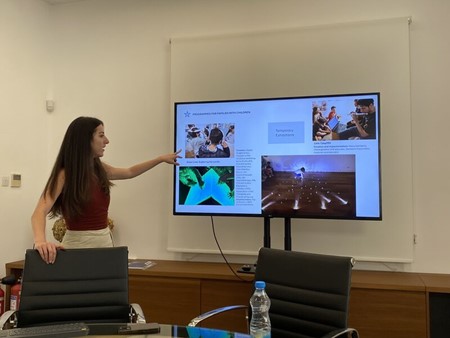Testimonials from EMA Summer School Attendees
Leventis Municipal Museum of Nicosia and A.G. Leventis Gallery, Cyprus
Karla Sosa Andrade
This summer, I had the opportunity to take part in the Summer School of the European Museum Academy held in Nicosia, Cyprus. It was an incredibly enriching experience, both professionally and personally.
As part of the programme, we closely explored the operations of two key cultural institutions in Cyprus: the Leventis Municipal Museum of Nicosia and the A. G. Leventis Gallery. At both, we had direct access to various departments—from management and curatorship to museography, education, communications and collections—and we gained first-hand insight into how a strong museum project is structured, one with significant historical and artistic impact respectively.
It was truly inspiring and meaningful for my professional development to learn about the work carried out by these institutions, their commitment to the local context, and the passion of their team members.
The list of people who made this possible is a long one. Thank you all for so generously sharing your knowledge and for opening the doors of your museums, your expertise, and above all, your wonderful country.

Landskrona Museum, Sweden
Eleni Tsonis
Just finished up two weeks of summer school in Landskrona, Sweden, hosted by the European Museum Academy and Kathrin Pabst, where the focus was on the European museum landscape, working with the untold/difficult narratives, and emotional wellbeing in the museum industry.
In these sessions we were specifically able to discuss the various ethical dilemmas that arise in a museum context and how to locate them within the ICOM code of ethics framework, contributing to a new perspective on the spectrum of tension and opportunity in a museum setting.
Thank you so much to the Landskrona Museum team, the European Museum Academy, and Dr. Pabst for your expertise!
Helina Nyamekye-Frimpong
As part of the EDUMaH (Education in Museums and Heritage) program, we had the incredible opportunity to take part in a summer school in collaboration with the European Museum Academy (EMA) - hosted at the Landskrona Museum in Sweden.
We explored the museum’s activities, learned about its initiatives, and even contributed some observations and reflections on their ongoing projects. It was a privilege to learn from Kathrin Pabst from EMA, whose knowledge and insights into the museum field were truly inspiring.
We also visited the beautiful Ven Island, where we explored the cathedral, enjoyed some lovely local restaurants, and learned from the Tycho Brahe Museum, observing and experiencing first-hand some of the innovative ideas the museum is developing.
It was a wonderful balance of learning, collaboration, and fun, engaging deeply with museum practice while bonding with amazing colleagues.



Jamtli Östersund, Sweden
Sithani Jayatissa
Participating in the two-week summer school at Jamtli in Sweden offered a valuable opportunity to combine theoretical knowledge with hands-on museum experiences. During the first week, sessions by Henrik Zipsane from EMA provided in-depth insights into key topics in the field of museums. The session on museum learning emphasized the importance of maintaining authenticity and authority while also striving for greater inclusivity.
Overall, the two-week summer school at Jamtli gave me a profound understanding of how complex and sensitive the museum field truly is. Museums must constantly balance multiple responsibilities; responding to shifting socio-economic conditions, navigating political influences, and meeting the needs of increasingly diverse and critical audiences. What became clear to me is that working in a museum requires not only professional knowledge and skills, but also deep ethical awareness, empathy, and genuine passion for preserving and sharing heritage.
Through both theoretical sessions and hands-on experiences, I saw how museums must carefully consider every decision from interpretation and representation to funding and education strategies. Whether roleplaying in historical settings, observing intergenerational learning, or reflecting on the representation of Indigenous voices, I began to appreciate how every detail contributes to shaping public understanding and trust. This experience strengthened my belief that museums are not neutral institutions; they are active agents of learning, inclusion, and identity-making.
Personally, the summer school allowed me to connect theory with practice and gave me valuable tools to think critically and creatively about museum work. It reaffirmed my interest in museum education and heritage interpretation and encouraged me to think more deeply about my own role as a future museum professional committed to ethical and inclusive practice. The insights and reflections I gained at Jamtli will continue to shape my academic journey and professional development in meaningful ways.
I would like to express my sincere gratitude to all the resource persons who generously shared their knowledge and experience throughout the summer school. Special thanks to Henrik Zipsane, Tilda Knutsson, Charina Knutsson, Emma Olofsson for their inspiring contributions and thought-provoking discussions. I am especially grateful to Helena Kuhlefelt and Anna Stugvard from NCK for their kind support and efforts in making our stay comfortable and enriching. I also want to extend my appreciation to all the staff and actors of Historyland for their warm interactions and for openly sharing their experiences, which added so much depth to my learning. This opportunity has been truly valuable, and I am thankful for everyone who made it possible.

Museum Odense, Denmark
Rita Abdelnour
It has been a very rewarding experience, especially for me who has been yearning for a similar intersection between literature, education and culture.
I've been very lucky to be offered such a close up view of your philosophy and your methods. Thank you all for your generosity and your trust. The workshop was very enjoyable and enriching (from the creative work, the facilitation, and the debriefing sessions).
I will be drawing on this experience as a model on how museums best communicate with their visitors.


